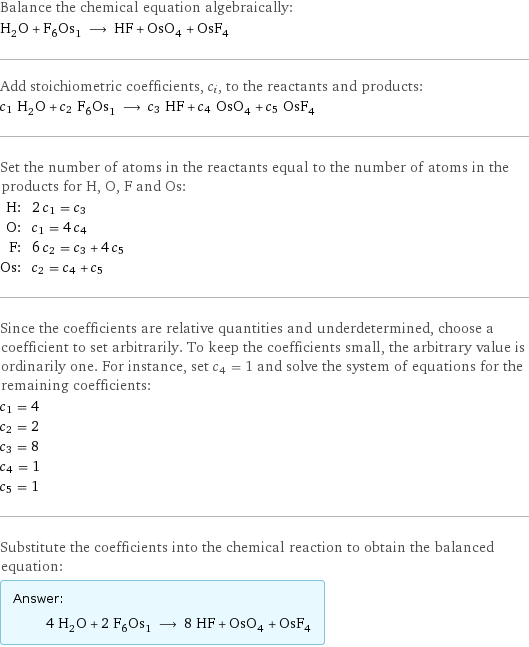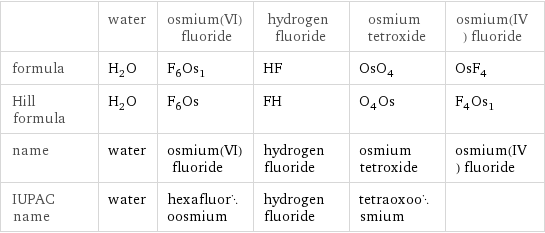Input interpretation

H_2O water + F_6Os_1 osmium(VI) fluoride ⟶ HF hydrogen fluoride + OsO_4 osmium tetroxide + OsF_4 osmium(IV) fluoride
Balanced equation

Balance the chemical equation algebraically: H_2O + F_6Os_1 ⟶ HF + OsO_4 + OsF_4 Add stoichiometric coefficients, c_i, to the reactants and products: c_1 H_2O + c_2 F_6Os_1 ⟶ c_3 HF + c_4 OsO_4 + c_5 OsF_4 Set the number of atoms in the reactants equal to the number of atoms in the products for H, O, F and Os: H: | 2 c_1 = c_3 O: | c_1 = 4 c_4 F: | 6 c_2 = c_3 + 4 c_5 Os: | c_2 = c_4 + c_5 Since the coefficients are relative quantities and underdetermined, choose a coefficient to set arbitrarily. To keep the coefficients small, the arbitrary value is ordinarily one. For instance, set c_4 = 1 and solve the system of equations for the remaining coefficients: c_1 = 4 c_2 = 2 c_3 = 8 c_4 = 1 c_5 = 1 Substitute the coefficients into the chemical reaction to obtain the balanced equation: Answer: | | 4 H_2O + 2 F_6Os_1 ⟶ 8 HF + OsO_4 + OsF_4
Structures

+ ⟶ + +
Names

water + osmium(VI) fluoride ⟶ hydrogen fluoride + osmium tetroxide + osmium(IV) fluoride
Equilibrium constant
![Construct the equilibrium constant, K, expression for: H_2O + F_6Os_1 ⟶ HF + OsO_4 + OsF_4 Plan: • Balance the chemical equation. • Determine the stoichiometric numbers. • Assemble the activity expression for each chemical species. • Use the activity expressions to build the equilibrium constant expression. Write the balanced chemical equation: 4 H_2O + 2 F_6Os_1 ⟶ 8 HF + OsO_4 + OsF_4 Assign stoichiometric numbers, ν_i, using the stoichiometric coefficients, c_i, from the balanced chemical equation in the following manner: ν_i = -c_i for reactants and ν_i = c_i for products: chemical species | c_i | ν_i H_2O | 4 | -4 F_6Os_1 | 2 | -2 HF | 8 | 8 OsO_4 | 1 | 1 OsF_4 | 1 | 1 Assemble the activity expressions accounting for the state of matter and ν_i: chemical species | c_i | ν_i | activity expression H_2O | 4 | -4 | ([H2O])^(-4) F_6Os_1 | 2 | -2 | ([F6Os1])^(-2) HF | 8 | 8 | ([HF])^8 OsO_4 | 1 | 1 | [OsO4] OsF_4 | 1 | 1 | [OsF4] The equilibrium constant symbol in the concentration basis is: K_c Mulitply the activity expressions to arrive at the K_c expression: Answer: | | K_c = ([H2O])^(-4) ([F6Os1])^(-2) ([HF])^8 [OsO4] [OsF4] = (([HF])^8 [OsO4] [OsF4])/(([H2O])^4 ([F6Os1])^2)](../image_source/ecea7817e3e0196768c00c79f047bfff.png)
Construct the equilibrium constant, K, expression for: H_2O + F_6Os_1 ⟶ HF + OsO_4 + OsF_4 Plan: • Balance the chemical equation. • Determine the stoichiometric numbers. • Assemble the activity expression for each chemical species. • Use the activity expressions to build the equilibrium constant expression. Write the balanced chemical equation: 4 H_2O + 2 F_6Os_1 ⟶ 8 HF + OsO_4 + OsF_4 Assign stoichiometric numbers, ν_i, using the stoichiometric coefficients, c_i, from the balanced chemical equation in the following manner: ν_i = -c_i for reactants and ν_i = c_i for products: chemical species | c_i | ν_i H_2O | 4 | -4 F_6Os_1 | 2 | -2 HF | 8 | 8 OsO_4 | 1 | 1 OsF_4 | 1 | 1 Assemble the activity expressions accounting for the state of matter and ν_i: chemical species | c_i | ν_i | activity expression H_2O | 4 | -4 | ([H2O])^(-4) F_6Os_1 | 2 | -2 | ([F6Os1])^(-2) HF | 8 | 8 | ([HF])^8 OsO_4 | 1 | 1 | [OsO4] OsF_4 | 1 | 1 | [OsF4] The equilibrium constant symbol in the concentration basis is: K_c Mulitply the activity expressions to arrive at the K_c expression: Answer: | | K_c = ([H2O])^(-4) ([F6Os1])^(-2) ([HF])^8 [OsO4] [OsF4] = (([HF])^8 [OsO4] [OsF4])/(([H2O])^4 ([F6Os1])^2)
Rate of reaction
![Construct the rate of reaction expression for: H_2O + F_6Os_1 ⟶ HF + OsO_4 + OsF_4 Plan: • Balance the chemical equation. • Determine the stoichiometric numbers. • Assemble the rate term for each chemical species. • Write the rate of reaction expression. Write the balanced chemical equation: 4 H_2O + 2 F_6Os_1 ⟶ 8 HF + OsO_4 + OsF_4 Assign stoichiometric numbers, ν_i, using the stoichiometric coefficients, c_i, from the balanced chemical equation in the following manner: ν_i = -c_i for reactants and ν_i = c_i for products: chemical species | c_i | ν_i H_2O | 4 | -4 F_6Os_1 | 2 | -2 HF | 8 | 8 OsO_4 | 1 | 1 OsF_4 | 1 | 1 The rate term for each chemical species, B_i, is 1/ν_i(Δ[B_i])/(Δt) where [B_i] is the amount concentration and t is time: chemical species | c_i | ν_i | rate term H_2O | 4 | -4 | -1/4 (Δ[H2O])/(Δt) F_6Os_1 | 2 | -2 | -1/2 (Δ[F6Os1])/(Δt) HF | 8 | 8 | 1/8 (Δ[HF])/(Δt) OsO_4 | 1 | 1 | (Δ[OsO4])/(Δt) OsF_4 | 1 | 1 | (Δ[OsF4])/(Δt) (for infinitesimal rate of change, replace Δ with d) Set the rate terms equal to each other to arrive at the rate expression: Answer: | | rate = -1/4 (Δ[H2O])/(Δt) = -1/2 (Δ[F6Os1])/(Δt) = 1/8 (Δ[HF])/(Δt) = (Δ[OsO4])/(Δt) = (Δ[OsF4])/(Δt) (assuming constant volume and no accumulation of intermediates or side products)](../image_source/3438e25b5dd9827fa90a9e2011d893b4.png)
Construct the rate of reaction expression for: H_2O + F_6Os_1 ⟶ HF + OsO_4 + OsF_4 Plan: • Balance the chemical equation. • Determine the stoichiometric numbers. • Assemble the rate term for each chemical species. • Write the rate of reaction expression. Write the balanced chemical equation: 4 H_2O + 2 F_6Os_1 ⟶ 8 HF + OsO_4 + OsF_4 Assign stoichiometric numbers, ν_i, using the stoichiometric coefficients, c_i, from the balanced chemical equation in the following manner: ν_i = -c_i for reactants and ν_i = c_i for products: chemical species | c_i | ν_i H_2O | 4 | -4 F_6Os_1 | 2 | -2 HF | 8 | 8 OsO_4 | 1 | 1 OsF_4 | 1 | 1 The rate term for each chemical species, B_i, is 1/ν_i(Δ[B_i])/(Δt) where [B_i] is the amount concentration and t is time: chemical species | c_i | ν_i | rate term H_2O | 4 | -4 | -1/4 (Δ[H2O])/(Δt) F_6Os_1 | 2 | -2 | -1/2 (Δ[F6Os1])/(Δt) HF | 8 | 8 | 1/8 (Δ[HF])/(Δt) OsO_4 | 1 | 1 | (Δ[OsO4])/(Δt) OsF_4 | 1 | 1 | (Δ[OsF4])/(Δt) (for infinitesimal rate of change, replace Δ with d) Set the rate terms equal to each other to arrive at the rate expression: Answer: | | rate = -1/4 (Δ[H2O])/(Δt) = -1/2 (Δ[F6Os1])/(Δt) = 1/8 (Δ[HF])/(Δt) = (Δ[OsO4])/(Δt) = (Δ[OsF4])/(Δt) (assuming constant volume and no accumulation of intermediates or side products)
Chemical names and formulas

| water | osmium(VI) fluoride | hydrogen fluoride | osmium tetroxide | osmium(IV) fluoride formula | H_2O | F_6Os_1 | HF | OsO_4 | OsF_4 Hill formula | H_2O | F_6Os | FH | O_4Os | F_4Os_1 name | water | osmium(VI) fluoride | hydrogen fluoride | osmium tetroxide | osmium(IV) fluoride IUPAC name | water | hexafluoroosmium | hydrogen fluoride | tetraoxoosmium |